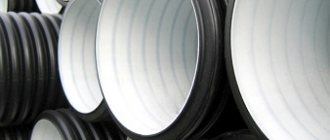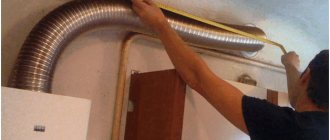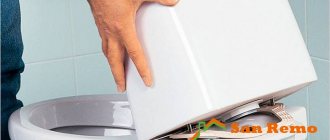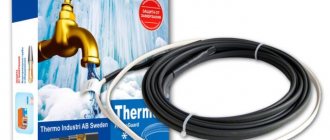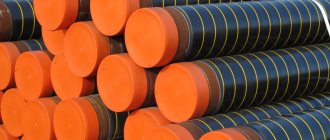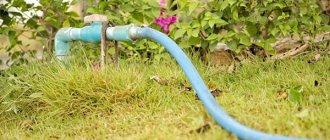Stainless steel corrugated pipes for heating began to be used relatively recently, although they have already gained well-deserved popularity in plumbing. Unique technical characteristics give it numerous advantages over products made from other materials. In this article we will familiarize ourselves with them in detail, and also consider the main features of installation work.
Photo of a heating system made of stainless corrugation
Installation methods
When laying water supply or communications for other purposes using stainless steel pipes, several types of connections are possible, namely:
- welded;
- use of flange type connecting elements;
- crimping.
To connect using water supply and heating networks, you will need not only special equipment, but also a qualified specialist. Such a process is usually carried out, and the welding itself is performed in an inert gas environment. The most modern method that allows high-quality joining of stainless pipes is plasma welding, which also requires the use of special and expensive equipment.
Press fittings provide high-quality connections and quick installation, but are expensive and require special tools
In domestic conditions, it is not always possible to use welding, since for this you need not only to have special equipment at your disposal, but also to attract a qualified specialist to operate it. In this regard, in such cases, threadless flange or threaded fitting connections are used.
Flanges are essentially two ring-shaped elements connected to each other using studs or bolts. To achieve tightness when using flanges, use a special sealing element made of rubber or other soft polymer material. Parts such as flanges, which are quite large in size, are used mainly when pipeline elements need to be periodically dismantled and maintained, spending a minimum of time. The disadvantages of connections of this type are that they react rather poorly to temperature changes and pressure surges in the pipeline.
The service life of fittings for corrugated pipes is practically unlimited; you only need to change the seals, which can last up to 30 years
A more reliable option are fittings, the design of which includes a silicone gasket that ensures tightness. You can dismantle such connections several times without worrying about their reliability.
Reviews and operating experience, recommendations
Corrugated stainless steel appeared only a few years ago. Therefore, the entire operating experience amounts to several years. The maximum that we could find on the forums was 7 years. What is typical is that there are no negative reviews - specifically, there are no reviews from those who have installed such pipes. There is a lot of negativity from specialists who produce other products from other materials, but they are all theoretical and speculative. Some are more true, others less so. The most plausible drawback is greater resistance to water flow than smooth-walled ones. Although none of those who installed flexible stainless steel heating pipes noted the need for more powerful circulation pumps. For many, this system works with wall-mounted gas boilers. Moreover, heated floors and conventional wiring are used.
The combination of qualities in a corrugated stainless pipe turned out to be very successful: the reliability of stainless steel and the flexibility of the corrugation makes it easy to assemble any system
There is a message from the owner of an apartment in Moscow: he shares his impressions of the installation - just a year and a half ago he changed the wiring: the flight is normal, there are no problems. He also cites the words of the installers, whom he identified as competent specialists (according to the criteria: speed of work + skills). So, they said that they have been installing corrugated stainless steel hoses for 8 years (reported 1.5 years), there have been no problems/calls for repairs. When choosing between Kofulso and Lavita, they recommend “Kofulso” - the quality is better.
There are some recommendations (use experience) for “high-temperature” applications in environments above 110 o C. It is advised to periodically, approximately once a year, check the condition of the gaskets. After a specified period of time they become “woody”. To avoid leaks, it is recommended to replace it (it costs a few rubles), the replacement itself takes a couple of minutes to unscrew, assess the condition and, if necessary, install another one and tighten it. They just recommend not to overdo it when tightening - if you use a wrench, do it without fanaticism at all - high-quality fittings hold well even when tightened by hand, but if the gaskets are pinched, they lose elasticity much faster.
There is experience in using such stainless corrugation in a bathhouse floor screed: two circuits (30 m and 15 m). One of the pipes is braided (recommended to eliminate problems with the reaction of metal to concrete) and one without - in its pure form. There are no problems - they have been lying around for 5 years. If you take into account the conditions in the bathhouse: very high humidity and high temperature, periodic freezing/thawing, then corrugated pipes for laying heating in the floor in an ordinary apartment/house can definitely be used, because the conditions are much better than in a bathhouse.
Another owner of heated floors made from stainless corrugated pipes advises doing it according to the principle - one bay - one circuit and not sealing the fittings tightly, but installing combs. He used an unannealed pipe, which he tied to a grate (photo).
Option for making a heated floor from stainless corrugation
There is another heated floor made of 20 mm corrugation with a pitch of 20 cm. It also operates without problems.
The situation is similar with the Kofulso pipe piping and Lavita fittings in the boiler room - for two years of operation there were no accidents or leaks (the fittings were taken from another company due to the fact that they have metal gaskets, which seemed to the owner more reliable than polymer ones).
Some even make radiators from it. This is what it looks like (see photo). They say that it heats well, because the heat transfer area is large. It will be problematic to wash such a radiator, but the solution is to install a protective decorative screen.
Even radiators are made from corrugated stainless pipes
Judging by the reviews, the picture is even too rosy: no one is complaining. This is even a little alarming. But maybe it’s just that not much time has passed: they began to actively install stainless corrugated pipes for heating just a few years ago and the “sides” have not yet come out. Although, if there were serious problems, they would have already manifested themselves, and negative messages would definitely appear: a person is more inclined to describe why he does not like the product than to write about problem-free operation.
Whether or not to install stainless steel corrugation for heating is up to everyone to decide for themselves, but everything looks quite attractive: prices, characteristics and ease of installation. Even the reviews are encouraging.
Specifications
Seamless stainless steel pipes are distinguished by their strength and resistance to rust. The absence of welds guarantees protection of products from heat-affected corrosion.
In comparison with electric-welded analogues, a number of advantages can be identified:
- The pipe does not have a weld, which is the most vulnerable area of the product.
- Has the same strength throughout.
In addition, such pipes are effectively operated at high media pressures and are able to withstand destructive external influences. This makes it possible to use them in conditions of high humidity, high and low ambient temperatures. The threshold temperature for a simple carrier is 800°C, for aggressive chemicals - 350°C.
Other important characteristics include:
- The tensile strength of the material is no less than 529 N/sq.mm.
- The relative elongation indicator is at least 40%.
- The sulfur content in steel is not less than 0.02%.
The permissible curvature of products is also strictly regulated and should not exceed the following values:
- Pipes with a wall thickness of more than 0.5 mm - 1 mm per 1 m of length.
- Products with a wall thickness of less than 0.5 mm and a cross-section of more than 15 mm - 2 mm per 1 m of length.
When purchasing, you should give preference to large hardware stores and products from popular brands. Perhaps the final cost will be slightly higher, but the buyer is guaranteed to receive a quality product with the required characteristics.
Manufacturers and what to look for when purchasing
There are currently the most Korean companies in our market:
- KOFULSO (“Kofulso”) - according to experts, the best quality, since it was the first to appear on the market and has quite a lot of production experience. It has twice the thickness of the seal rings in the fittings, and the weight of the fittings and coils of pipes of the same name is greater. So the increased cost (compared to Hydrosta and Lavita) is justified.
- Lavita (“Lavita”) - performs quite well, but there may be problems in the fittings - sometimes when tightening, the metal ring cuts through the wall (may be due to an installation error - tightening the clamping ring), which causes leaks (per 100 fittings 1-2) - costs less than Cofulso.
- Hydrosta (“Hydrosta” or “Hidrosta”) is in the same price category as Lavita, but there are complaints about leaking fittings: for every 100 installed, 5-7 pieces leak.
- Neptune (“Neptune”) – characteristics and reviews could not be found;
- Meibes (Meibas) - there are no complaints about the quality, but there are some for the price - very expensive with approximately equal parameters to those given above in the list.
The reliability data was taken from the installer’s post on the forum, this is the result of several years of use: first we worked with Cofulso, then switched to the cheaper Lavita and Hirostat, after replacing fittings and, accordingly, customer complaints, we weighed, looked, and returned to KOFULSO.
What’s good about stainless corrugated pipe is that there are no fakes yet. Maybe because a lot of equipment is required, and the technology is quite complex. Or maybe because the market is just developing, and there is no frantic demand for such products yet.
The video shows the production process of stainless corrugated pipe.
To calculate the volume of the heating system, you may need information about the amount of water contained in a linear meter of corrugated pipe:
- 15 mm - 0.219 l;
- 20 mm - 0.447 l;
- 25 mm - 71 l;
- 32 mm - 0.982 l.
And about the area of a linear meter of corrugation of the corresponding diameter:
- 15 mm - 0.064652 m2;
- 20 mm - 0.095004 m2;
- 25 mm - 0.121394 m2;
- 32 mm - 0.15218 m2.
What to pay attention to when purchasing: first, the pitch of the corrugation should be the same, the seam should be even and intact, there should be no chips, cracks or other damage. You can bend/unbend it several times - there should be no deformation or other consequences. When purchasing fittings, also pay attention to the appearance and completeness, paying special attention to the condition and quality of the sealing rings. The assortment of fittings is almost standard: all imaginable options are available in nature, but whether they will be available at each specific outlet is a question.
Corrugated pipes are connected/disconnected using fittings
Features of connecting seamless stainless pipes
The main competitive advantage of such products is the absence of welds, which are the most vulnerable point of any welded pipe. For this reason, increased quality and reliability requirements are placed on the connection procedure.
Pipes are joined only by welding, and the process can be carried out manually, semi-automatically or automatically. One of the following technologies is used:
- TIG. Welding is performed in an inert gas environment, which protects the treated area from oxidation. The heat source is an electric arc formed between the tungsten electrode and the welding point. If the technology is followed, the seam will be smooth, uniform and not inferior in strength characteristics to the material of the pipe itself.
- HF. A less expensive technology, which, however, does not provide similar strength indicators. Welding is performed using high-frequency current.
- Laser Laser welding is not inferior to TIG technology in terms of seam strength, while making it possible to reduce the melting zone and make the seam less noticeable.
Thus, seamless stainless steel pipes can be safely called one of the most practical, strong, durable and environmentally friendly pipe materials, allowing you to implement any project: from the installation of industrial pipelines to the manufacture of elegant furniture. The only disadvantage of such pipes is the justifiably high cost.
Advantages and disadvantages
Corrugated pipes have advantages because they can be used to solve many problems. Stainless steel corrugation has:
- flexibility, due to which no effort is required from a person, the use of special tools and the creation of many connections for bending the pipe, while the stainless steel corrugation is very durable;
- inertness to chemical influences and anti-corrosion properties - the working environment and atmospheric phenomena, pressure and temperature changes will not damage corrugated pipes, the possibility of electrochemical corrosion is easily reduced by grounding or a protective shell - all this seriously increases the service life of the pipeline, and also allows the use of such pipes in regions with long, frosty winters and for transporting low-temperature media (liquid nitrogen, for example);
- easy installation: to connect or replace any section, an open-end or adjustable wrench is enough;
- corrugated stainless steel pipes have a low roughness coefficient (0.008), which protects the system from contamination;
- corrugated pipes are lightweight - the weight is almost the same as that of polymer pipes, the noise level is low, and the price is reasonable (much cheaper than copper pipes);
- A separate advantage for large-scale work is its length: a standard 50 m of corrugation in one bay is enough to build any pipeline, and if necessary, a longer coil can be ordered from the manufacturer.
As for the disadvantages, they cannot cover all the advantages, and when choosing pipes they rarely influence the decision of buyers.
However, it is important to know about the disadvantages of corrugation in order to take these features into account, first of all, when maintaining pipes:
- The impact resistance of stainless steel corrugation is low, and if it is installed in an area where the risk of mechanical damage is high, the pipeline will have to be protected with a special casing.
- Such pipes are more difficult to maintain than smooth-walled ones: they are difficult to clean from dust; you need a brush, or even better, a protective screen that will protect the product from dirt.
- Externally, the corrugation looks unattractive, so it will have to be hidden, but access to the fittings must be left, which means it will no longer be possible to install the pipes monolithically.
- Access to corrugated pipes must be open, because the fittings require maintenance: regular checking of tightness, tightening or replacing the insert, etc.
Choosing a stainless steel chimney
The stainless steel chimney design includes cylindrical sections 1.0 and 0.5 meters long, as well as numerous additional elements:
- turns at an angle of 90, 120, 135 and 150 degrees;
- adapters for connecting pipes of a different size;
- adapters for connecting sandwich and single-wall pipes;
- tees for connecting junctions;
- gates or internal dampers for adjusting draft;
- clamps for strengthening the joints of pipe sections during installation;
- brackets for attaching the external chimney to the wall of the building;
- transition glasses for crossing ceilings and roof structures with a chimney.
In the delivery set, sellers offer various fasteners for mounting and installing the chimney.
In addition to the above, you must definitely purchase a pipe head or deflector. For solid fuel units, in some cases it is necessary to use a head with a spark arrester.
If the chimney is intended to remove wood combustion products, it can be equipped with a protective cap with a mesh spark arrester
The listed components for the chimney allow you to assemble a channel of any configuration. The following requirements must be taken into account:
The total length of the chimney must be more than 5 meters. Only if this condition is met can you count on normal traction. If it is necessary to install a horizontal transition on the chimney, its length should not exceed one meter. The use of more than two turns at gentle angles in the design is undesirable. This can negatively impact your cravings. When crossing interfloor ceilings and the roof, a fire-proof crossing is required. The design of the roof penetration depends on the angle of inclination of the slope
Here it is important to ensure not only fire safety, but also tightness.
The chimney inside the boiler room is made of single pipes without insulation; all its parts located in the cold room and the external component need thermal insulation, for example, using a sandwich pipe.
When purchasing materials, pipes and components must be checked with a magnet. Suitable quality stainless steel is not magnetic. It belongs to the austenitic class, resistant to heat and aggressive environments. A similar material of the ferritic or semi-ferritic class is susceptible to corrosion, although it belongs to the stainless steel family.
The internal size of the chimney pipe is always indicated in the technical documentation for the heating unit. If a homemade boiler or stove is installed, then the cross-section of the chimney is selected in a ratio of approximately 1:10 to the size of the combustion chamber. In private homes, pipes measuring 140–150 millimeters are usually used.
The data provided will be useful in selecting the material and completeness of the device.
Scope of application
The excellent performance qualities of corrugated pipes allow it to be used equally effectively in a variety of areas of the national economy:
- industry;
- agricultural enterprises;
- food production;
- chemical and pharmacological enterprises.
But corrugated stainless steel has won true popular love thanks to the ability to quickly and efficiently install any pipeline in an apartment or private house. The flexibility and versatility of corrugated materials are especially valuable in the cramped conditions of city apartments, where literally every centimeter of space can count.
We recommend that you read: Welding methods for connecting polyethylene pipes
There are often cases when communications have to be completely redone due to the fact that a few millimeters of pipe were missing during installation. A flexible corrugated pipe can always be laid in such a way that its length is exactly as long as necessary.
Corrugation is produced in standard coils of 50 meters, which makes it easy to install even the largest structures. If necessary, you can order pipes of any size and length from the manufacturer.
Note! The scope of application of corrugated pipes is not limited to water supply or heating systems. A hollow and flexible steel pipe will serve as excellent protection against moisture, rodents and mechanical damage for electrical cables.
Our advantages
Our company has chosen the installation of stainless pipelines as its main activity. The highest demands are placed on such work, and we fully meet them. We have everything necessary to carry out high-quality installation, namely:
- a permanent staff of qualified specialists who hone their professional skills by installing stainless steel pipelines at numerous sites both in the CIS and abroad;
- modern high-tech equipment designed for the installation of process pipelines made of stainless steel, which meets the high requirements of the market;
- the desire to become the best among competitors;
- confidence that our many clients, having appreciated the installation of stainless steel pipelines produced by our company, will turn to us again and again, and will also recommend us to their partners.
Customers often face a dilemma: to install a stainless pipeline using a company that has extensive successful experience in such work, or to entrust the work to a little-known company that is also ready to perform this work at a slightly lower price. At the same time, Customers should not forget that by entrusting the installation of a stainless steel pipeline to unqualified performers, they risk encountering serious problems during the commissioning of the equipment and during the production of the final product. Therefore, we recommend entrusting such responsible work to companies whose specialists have real experience in installing process pipelines.
Another confirmation of the company’s high professionalism is the number of its staff. Our company, unlike some of our competitors, has its own large and permanent staff. This confirms our focus on the high professional training of our specialists, who are always ready to install stainless pipelines for you with high quality and in the shortest possible time, regardless of the amount of work, the remoteness of the site and the complexity of the tasks.
Our goal and main priority is the Customer’s satisfaction with the result of cooperation with PUE “RViMA”. Installation of stainless pipelines, carried out at a high professional level, is the key to positive feedback about our work and contributes to the dynamic development of our company.
Types of flexible stainless steel pipes
In the last century, special attention was paid to the production of corrugated steel products. Their importance is difficult to overestimate: corrugations played a significant role in global structures, such as the Trans-Siberian Railway or the BAM. Stainless steel corrugated pipes can have completely different cross-sections - from 8 mm to 15 m. In addition to conventional water supply and gas flue corrugations, steel pipes with a non-standard cross-section are also produced:
- square (diameter 3-8 m) – used for constructing culverts and tunnels;
- arch pipes (2-13 m) – tunnels for travel under railways or road junctions;
- pear-shaped (1.5-8 m) – installation of a stainless steel culvert;
- vertical ellipse (1.5-6.5 m) – communication tunnels, culverts;
- arched (2-13 m) – pedestrian crossings, small bridges and road tunnels;
- horizontal ellipse (2.6-9 m) – water pipes;
- low profile arches (6-15 m) – railway and road tunnels.
Round corrugated pipes of large diameters (from 1.5 to 7 m) are used mainly in the construction of large-scale culvert structures. Smaller analogues will be used for private purposes, which will be discussed further.


